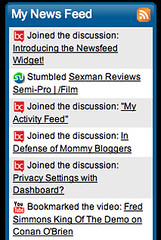Just days after beating MyBlogLog out of the gate with its Social Dashboard feature, BlogCatalog has moved forward to launch SocialStream, an RSS feed enabled widget that makes “lifestreaming” data portable. The widget makes it possible for BlogCatalog members to share their activity on BlogCatalog and 12 other social networks anywhere they want.
“Any network we add to our Dashboard feature can be added to the SocialStream widget,” says Antony Berkman, president of BlogCatalog.com. “It’s the next step toward putting people in more control of their data.”
Data portability is considered by many to be the next step in the evolution of social networks. While social networks have largely succeeded in helping bring people together based upon shared interests, each requires additional time to manage and update. Jimmy Guterman, editorial director of O’Reilly’s Radar Group, recently made note of this in his Social Graph Foo Report.
“So much about social networks and the next generation has been enveloped in hype … that overpromising in the short term on the data portability front could have severe public relations ramifications,” he wrote. “Data portability has to be real, not merely allowing someone to access information from social network B while inside social network A.”
The BlogCatalog widget is a step in true data portability because it takes a concept some people, like me, have been experimenting with on platforms like Tumblr and allowing bloggers to customize the content of the widget and place it virtually anywhere they want —on a Web site, blog, or even another social network that allows the addition of widgets.
Practicalities In Portable Data.
One of the tangible benefits of a social network RSS feed is that activities across social networks can now add content value to the blog. With the widget, bloggers can share discussions on other social networks; their readers can also subscribe to the widget.
At the same time, it answers some of the questions being asked by people like Lewis Green, who recently noted how much time he invests in social networks rather then his or other blogs, and David Recordon, who recently wrote about the growing challenge of social network fatigue.
By installing the widget, assuming you want to share some or all of your social network activities, people who read your blog receive updates from Amazon Wishlists, BlogCatalog, Delicious, Digg, Facebook, Flickr, Last.fm, Multiply, MySpace, Sphinn, StumbleUpon, Twitter, and YouTube.
Berkman says they will continue to add more social networks. Originally, the BlogCatalog Dashboard started with connections to nine social networks. It now includes 12. Berkman said what is most exciting for him and his development team is to assist bloggers in helping their material become viral.
“It will help friends and blog readers find out if you Digg an article so they can Digg it too,” says Berkman. “This makes it easier to navigate the Web and increases the likelihood that something will go viral because it appears wherever people share their widget.”
The widget also solves a challenge for bloggers with multiple blogs. Many of them would invest hours of time writing about their social activities on several blogs. The widget can be installed on all of their blogs, which would allow them to write a post on one blog, include the link on a social network like Twitter, and then seed their post across all of their blogs via the widget.
What’s next? It’s hard to say. Speed to market has never been an issue for a fast-moving social network like BlogCatalog. To give just one small example: Despite working with BlogCatalog as a communication consultant, I found out the BlogCatalog team was launching the SocialStream widget just a few hours prior to the announcement.
It didn’t even have a name when I received the call. That is an amazing contrast to something that many companies would have discussed for months. Fortunately, several years of political experience has made rapid response a second nature skill set. Only political campaign teams move as fast.

“Any network we add to our Dashboard feature can be added to the SocialStream widget,” says Antony Berkman, president of BlogCatalog.com. “It’s the next step toward putting people in more control of their data.”
Data portability is considered by many to be the next step in the evolution of social networks. While social networks have largely succeeded in helping bring people together based upon shared interests, each requires additional time to manage and update. Jimmy Guterman, editorial director of O’Reilly’s Radar Group, recently made note of this in his Social Graph Foo Report.
“So much about social networks and the next generation has been enveloped in hype … that overpromising in the short term on the data portability front could have severe public relations ramifications,” he wrote. “Data portability has to be real, not merely allowing someone to access information from social network B while inside social network A.”
The BlogCatalog widget is a step in true data portability because it takes a concept some people, like me, have been experimenting with on platforms like Tumblr and allowing bloggers to customize the content of the widget and place it virtually anywhere they want —on a Web site, blog, or even another social network that allows the addition of widgets.
Practicalities In Portable Data.
One of the tangible benefits of a social network RSS feed is that activities across social networks can now add content value to the blog. With the widget, bloggers can share discussions on other social networks; their readers can also subscribe to the widget.
At the same time, it answers some of the questions being asked by people like Lewis Green, who recently noted how much time he invests in social networks rather then his or other blogs, and David Recordon, who recently wrote about the growing challenge of social network fatigue.
By installing the widget, assuming you want to share some or all of your social network activities, people who read your blog receive updates from Amazon Wishlists, BlogCatalog, Delicious, Digg, Facebook, Flickr, Last.fm, Multiply, MySpace, Sphinn, StumbleUpon, Twitter, and YouTube.
Berkman says they will continue to add more social networks. Originally, the BlogCatalog Dashboard started with connections to nine social networks. It now includes 12. Berkman said what is most exciting for him and his development team is to assist bloggers in helping their material become viral.
“It will help friends and blog readers find out if you Digg an article so they can Digg it too,” says Berkman. “This makes it easier to navigate the Web and increases the likelihood that something will go viral because it appears wherever people share their widget.”
The widget also solves a challenge for bloggers with multiple blogs. Many of them would invest hours of time writing about their social activities on several blogs. The widget can be installed on all of their blogs, which would allow them to write a post on one blog, include the link on a social network like Twitter, and then seed their post across all of their blogs via the widget.
What’s next? It’s hard to say. Speed to market has never been an issue for a fast-moving social network like BlogCatalog. To give just one small example: Despite working with BlogCatalog as a communication consultant, I found out the BlogCatalog team was launching the SocialStream widget just a few hours prior to the announcement.
It didn’t even have a name when I received the call. That is an amazing contrast to something that many companies would have discussed for months. Fortunately, several years of political experience has made rapid response a second nature skill set. Only political campaign teams move as fast.






















